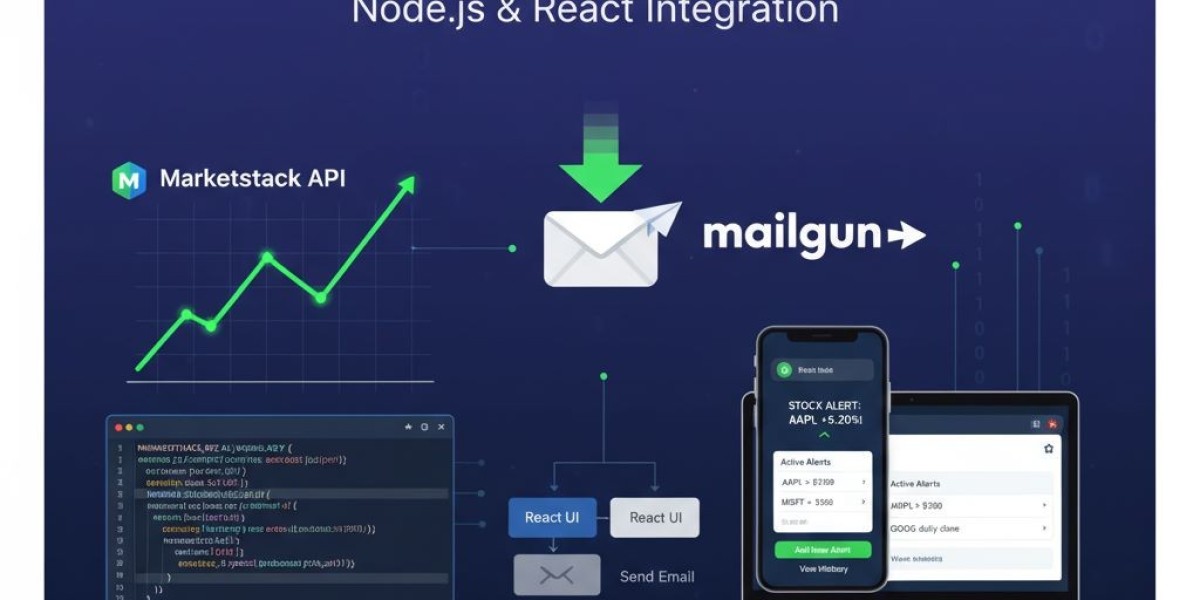Real-time stock alerts are crucial for investors, traders, and enthusiasts alike. Manual tracking of stock prices is not only tedious but also prone to delays, which can lead to missed opportunities. For developers, building a system that automates notifications ensures that users receive timely updates, enabling smarter decisions. By combining stock alert automation with Marketstack and transactional email stock notifications, developers can create scalable, reliable solutions for delivering financial data directly to users’ inboxes.
This guide walks through the key components, best practices, and implementation steps for building a robust stock alert system.
Why Stock Alert Automation is Essential
Automating stock alerts benefits both developers and end users. Here’s why:
- Real-Time Updates: Alerts are sent instantly when stock prices hit user-defined thresholds.
- Reduced Manual Effort: Users no longer need to monitor stock prices continuously.
- Personalization: Notifications can be tailored to individual portfolios and preferences.
- Enhanced Engagement: Timely alerts increase user satisfaction and retention.
For developers, automation reduces server load and streamlines data processing, making applications more efficient and scalable.
Key Tools for Building a Stock Alert System
To implement a functional stock alert system, developers need reliable APIs, backend frameworks, and email delivery services. Here’s a breakdown:
1. Marketstack API
Marketstack provides comprehensive stock market data, including:
- Real-time and historical stock prices.
- Intraday and end-of-day (EOD) data.
- Support for multiple stock symbols and markets worldwide.
Integrating Marketstack allows developers to fetch accurate stock data programmatically, which forms the backbone of any automated alert system.
2. Node.js Backend
Node.js is a popular choice for backend development due to its asynchronous, event-driven architecture. It allows developers to:
- Poll stock data at regular intervals.
- Process alerts for multiple users concurrently.
- Send automated notifications efficiently without blocking processes.
With Node.js, your application can handle high volumes of data requests and email notifications simultaneously.
3. React Frontend
React is ideal for building interactive dashboards and user interfaces. For a stock alert system, React can:
- Allow users to configure alert thresholds.
- Display live stock data and alert statuses.
- Provide a user-friendly interface for managing multiple stocks.
React’s modular architecture makes it easy to expand features as the application grows.
4. Transactional Email Services
Transactional email services, such as Mailgun, SendGrid, or Postmark, ensure reliable delivery of notifications. These tools provide:
- High deliverability rates for email alerts.
- Analytics on email performance, including opens and clicks.
- Scalability to handle thousands of emails per day.
Using transactional email stock notifications ensures that critical stock updates reach users promptly.
Building a Stock Alert Automation System
Implementing stock alert automation with Marketstack involves several key steps:
Step 1: Set Up the Node.js Backend
- Initialize a Node.js project with npm init.
- Install required packages like express for the server, axios for API requests, and a transactional email library (mailgun-js, @sendgrid/mail, etc.).
- Create endpoints to fetch stock data and trigger email alerts.
Example:
const express = require('express');
const axios = require('axios');
const mailgun = require('mailgun-js');
const app = express();
const mg = mailgun({ apiKey: process.env.MAILGUN_API_KEY, domain: process.env.MAILGUN_DOMAIN });
app.get('/stock-alert', async (req, res) => {
const { symbol, email } = req.query;
try {
const response = await axios.get(`https://api.marketstack.com/v1/eod?access_key=${process.env.MARKETSTACK_KEY}&symbols=${symbol}`);
const price = response.data.data[0].close;
if(price > 100) { // Example alert condition
mg.messages().send({
from: 'alerts@yourdomain.com',
to: email,
subject: `Stock Alert: ${symbol}`,
text: `The stock price of ${symbol} is now ${price}`
}, (error, body) => {
if(error) console.error(error);
});
}
res.send({ price });
} catch(error) {
console.error(error);
res.status(500).send('Error fetching stock data');
}
});
app.listen(3000, () => console.log('Server running on port 3000'));
This backend fetches stock prices and sends transactional email stock notifications when conditions are met.
Step 2: Build the React Frontend
- Initialize a React app using create-react-app.
- Create components for the dashboard and alert configuration.
- Connect the frontend to the Node.js backend using Axios or Fetch API.
Example component:
import { useState } from 'react';
import axios from 'axios';
function StockAlertForm() {
const [symbol, setSymbol] = useState('');
const [email, setEmail] = useState('');
const handleSubmit = async (e) => {
e.preventDefault();
await axios.get(`/stock-alert?symbol=${symbol}&email=${email}`);
alert('Stock alert setup successfully!');
};
return (
<form onSubmit={handleSubmit}>
<input value={symbol} onChange={e => setSymbol(e.target.value)} placeholder="Stock Symbol" />
<input value={email} onChange={e => setEmail(e.target.value)} placeholder="Email Address" />
<button type="submit">Set Alert</button>
</form>
);
}
export default StockAlertForm;
This interface lets users subscribe to stock alerts and ensures seamless interaction with the backend.
Step 3: Automate Alerts
Automation can be achieved using Node.js scheduling libraries like node-cron to periodically check stock prices and send alerts automatically.
Example:
const cron = require('node-cron');
cron.schedule('*/5 * * * *', () => { // Runs every 5 minutes
console.log('Checking stock prices...');
// Fetch stock data and send email alerts
});
Best Practices for Stock Alert Automation
- Avoid Spam Filters: Ensure emails include proper headers and opt-out options.
- Personalize Alerts: Tailor messages with user-specific stock data.
- Optimize Alert Frequency: Prevent overwhelming users by setting appropriate thresholds.
- Implement Error Handling: Log API or email delivery errors for troubleshooting.
- Secure API Keys: Store sensitive keys in environment variables, not in code.
Following these practices ensures a professional, reliable, and scalable system.
Frequently Asked Questions (FAQs)
1. What is Marketstack and why is it used for stock alert automation?
Marketstack is a stock market API providing real-time and historical stock data. It’s ideal for developers building automated alert systems due to its reliability and comprehensive coverage.
2. How do transactional email stock notifications work?
These are automated emails triggered by specific stock events, such as price changes or threshold breaches, delivered via email services like Mailgun or SendGrid.
3. Can I use this system for multiple users?
Yes. Node.js and transactional email services can scale to handle thousands of users simultaneously.
4. Is React necessary for building the system?
React is optional but helps create interactive dashboards for configuring and managing alerts.
5. How frequently should stock prices be checked?
It depends on your use case. Intraday trading may require frequent checks every few minutes, whereas long-term tracking can use daily updates.
6. Are there alternatives to Mailgun for email notifications?
Yes. SendGrid, Postmark, and Amazon SES are popular alternatives for reliable email delivery.
7. How secure is this system?
Security depends on proper API key management, HTTPS usage, and validation to prevent unauthorized access.
8. Can I add other notification channels like SMS or push notifications?
Yes, integrating services like Twilio or Firebase allows multi-channel notifications beyond email.
9. Can alerts be customized for multiple stocks?
Absolutely. Users can set different thresholds for each stock they want to track.
10. Where can I find the complete tutorial for building this system?
The full step-by-step guide is available at Automated Stock Alerts with Marketstack, Mailgun, Node.js, and React.
Implementing stock alert automation with Marketstack and transactional email stock notifications allows developers to build powerful tools for investors and traders. This system streamlines the delivery of critical stock updates, reduces manual tracking, and enhances user engagement.
By leveraging Node.js for backend processing, React for the frontend interface, and reliable email services for notifications, developers can create scalable and robust solutions tailored to user needs. Following best practices ensures high reliability, security, and professional user experience.
Ready to implement your own automated stock alert system? Explore our detailed tutorial on Automated Stock Alerts with Marketstack, Mailgun, Node.js, and React and start delivering real-time stock notifications to your users today!








